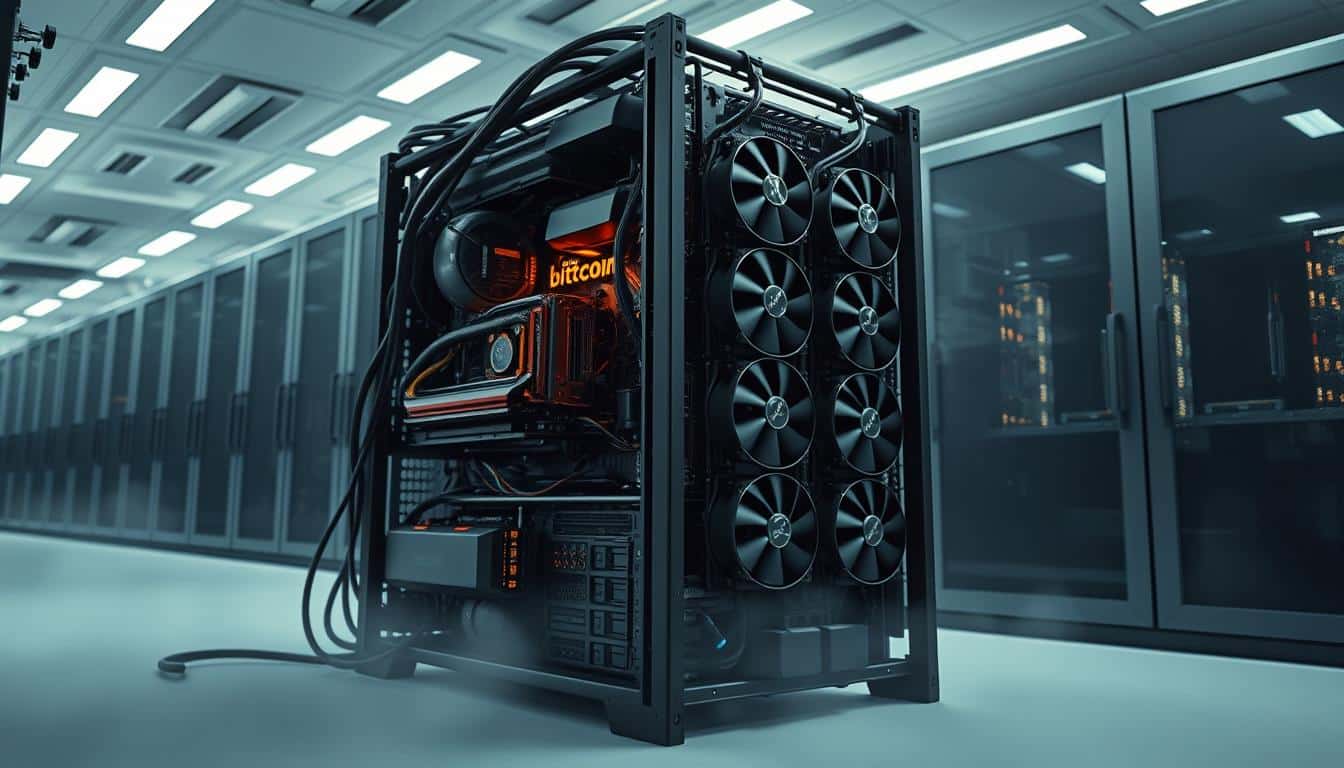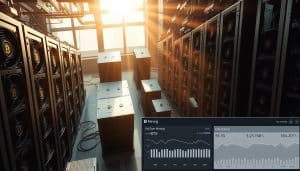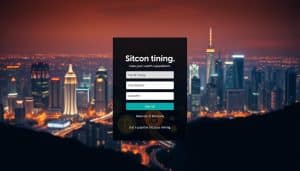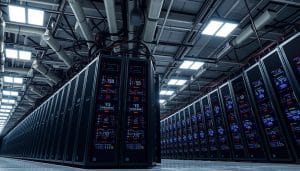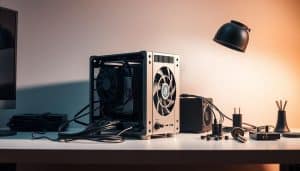Surprising fact: the current block subsidy sits at 3.125 BTC per block, and two pools control roughly 60% of the hashrate — a scale that shapes every hobbyist effort.
I’ll start by answering the core question, then map each item to the tools I use: an ASIC miner, a matched power supply, high‑gauge cabling, wired Ethernet, and cooling plus sound control.
Quick reality check from the data: home setup costs usually range from about $2,630 to $23,850 depending on the ASIC model, PSU, cooling, and networking choices. Noise runs 75–90 dB, so plan for soundproofing if you value quiet.
Expect a short FAQ here: how much does it cost, how loud will a miner be, can I use Wi‑Fi, and which pools matter. I point you later to tools and step‑by‑step setup for firmware, airflow, and payouts.
Bottom line: bitcoin mining favors scale, but a thoughtful home rig can work if you track power, pool fees, and real-world network uptime.
Key Takeaways
- Block reward: 3.125 BTC plus transactions and fees drive earnings.
- Core gear: ASIC, PSU, cabling, wired Ethernet, cooling, and surge protection.
- Costs vary: expect ~$2.6k–$24k for a proper home build.
- Noise & heat: ASICs are loud; plan sound control and airflow.
- Pools & uptime: choose pools with low fees and reliable network connections.
- Tools I use: CGMiner/EasyMiner, temp probes, and a hardware wallet for payouts.
Quick primer: how Bitcoin mining works on today’s network
I’ll give the short, practical version. In simple terms, miners gather pending transactions into a candidate block. Then they run that block through SHA‑256 while changing a nonce. Each attempt produces a hash. The first miner to find a hash below the target wins the right to add the new block and collect the reward: 3.125 BTC plus transaction fees.
Proof‑of‑Work is trial and error. Picture a hash like 0000000000000000000a3f… — those leading zeros show a low enough result. Miners perform billions of nonce tries per second until the math lines up.
The system adjusts difficulty every 2016 blocks (about two weeks) so average block time stays near 10 minutes. That retarget keeps supply predictable even if total hashrate jumps.
- Example: Foundry USA and Antpool together held ~60% of hashrate in early 2025.
- Practical note: rewards + fees make the revenue line — fees spike with mempool congestion and shift payouts.
- Tradeoff: more energy spent equals stronger network security, but shrinking share for small rigs as difficulty rises.
| Metric | Value | Impact for home miners |
|---|---|---|
| Block reward | 3.125 BTC | Primary income source; halving cadence caps supply growth |
| Retarget interval | 2016 blocks (~2 weeks) | Keeps block time ~10 minutes; affects margins |
| Pool dominance | Foundry+Antpool ~60% | Pooling reduces variance; consider fees and reliability |
“Energy in, security out — that’s the network’s core trade: huge compute makes attacks impractical.”
what equipment is needed to mine bitcoin
Let me walk you through the practical kit I use for small-scale rigs and why each item matters.
Core mining hardware: ASICs, PSUs, and cabling
I start with an ASIC — application-specific integrated hardware built for SHA‑256. Examples I handle: Bitmain Antminer S21 Pro (234 TH/s), Whatsminer M66S (298 TH/s), and Canaan Avalon A1566 (150 TH/s).
Match that with a quality power supply sized ~20% above continuous draw. Prefer 200–250VAC wiring where possible for better efficiency. Use thick, labeled 10/12‑gauge cords and a surge‑protected breaker.
Supporting gear: cooling, soundproofing, surge protection, Ethernet
Cooling and noise control are nonnegotiable. Budget fans or ducting ($50–$500) or consider immersion for serious heat ($2k–$10k). Acoustic panels run $100–$1,000.
Run wired Ethernet, a small switch, and a UPS so the network and shares stay stable. Add temperature probes, dust filters, and spare cables.
Secure storage: wallet choices for payouts
For pool payouts use a lightweight non‑custodial wallet. Move larger balances to a hardware wallet like a Ledger or Trezor for long‑term holding.
“Spec the PSU with headroom, tame heat, and protect your keys — everything else is detail.”
| Item | Example | Notes |
|---|---|---|
| ASIC | Antminer S21 Pro | 234 TH/s, ~15 J/TH |
| PSU | Matched OEM or Corsair | 20% headroom; 200–250VAC preferred |
| Cooling / Noise | Fans, panels, immersion | $50–$10,000 depending on approach |
Top ASIC miners and specs to consider in the present market
I ran side‑by‑side numbers on three popular miners so you can see tradeoffs clearly.
Quick snapshot: Antminer S21 Pro — 234 TH/s, ~3,510W (~15 J/TH). Whatsminer M66S — 298 TH/s, ~5,513W (~18 J/TH). Avalon A1566 — 150 TH/s, ~3,225W (~21.5 J/TH).
How to read efficiency and balance purchase price
When I compare application-specific integrated rigs I normalize hashrate by J/TH. Efficiency drives ongoing electricity bills and often eclipses purchase costs.
Rule of thumb: if your electricity is high, pick the lowest J/TH you can afford. If electricity is cheap, higher hash at worse efficiency can still work.
“Total cost of ownership = purchase price + power consumption + maintenance — efficiency compounds every hour.”
| Model | Hashrate | Power | Efficiency (J/TH) |
|---|---|---|---|
| Antminer S21 Pro | 234 TH/s | ~3,510 W | ~15 J/TH |
| Whatsminer M66S | 298 TH/s | ~5,513 W | ~18 J/TH |
| Avalon A1566 | 150 TH/s | ~3,225 W | ~21.5 J/TH |
Check firmware maturity, thermal behavior, and resale value before buying. I always model scenarios for BTC price, difficulty, pool fees, and electricity rate to estimate profitability.
Step-by-step setup guide: from unboxing to your first mining share
Start by laying out a clean workspace and a checklist—this step saves hours later. Unbox the miner, inspect for shipping damage, and note serial numbers. Place the unit on a rack or shelf in a cool, ventilated spot with exhaust routed out.
Physical hookup and firmware
Seat power leads firmly. Attach the matched PSU and never hot‑plug hashboards. Connect Ethernet to a stable switch and grab the miner’s IP from your router.
Update firmware only with the latest stable build from the manufacturer. That patches bugs and often improves efficiency.
Pool vs. solo configuration
For pool mode: enter the pool URL, your worker name, and payout address. Double‑check the stratum endpoint and pick a nearby region to cut stale shares.
For solo mining: run a fully synced Bitcoin Core node on another machine, open the required ports, and point the miner at the node IP. Expect low odds of finding a block alone.
First run checklist and verification
- Watch temps, fan RPMs, and the reported hash rate ramp.
- Confirm accepted shares and minimal rejects on the miner and pool dashboard.
- Log baseline metrics: hashrate, board temps, inlet/outlet air temps.
- Snapshot config files and firmware versions for fast recovery.
“Observe, record, and act—small adjustments early prevent big failures later.”
Final tip: if fans scream or temps jump, pause and rework airflow or underclock slightly. A steady miner that posts accepted shares wins rewards over time.
Power supply, electricity, and thermal management
Power and heat are the two realities that decide whether a rig stays profitable or becomes a costly paperweight.
Power supply selection matters: I pick a PSU rated ~20% above continuous draw so transient spikes don’t trip protections. Many PSUs run cooler and slightly more efficiently on 200–250VAC. For a single mid‑range asic miner (3,500W), plan a PSU and circuit that handle ~4,200W peak.
My electricity math lives in a spreadsheet: measured kW × $/kWh × 24 × 30 gives monthly consumption costs. Many hobbyists target ≤$0.05/kWh for workable margins.
Cooling and noise: options and ranges
Airflow first: clean intakes, directed exhaust, and ducting to outdoors solve many thermal issues. Fans and ducting cost $50–$500. Immersion runs $2,000–$10,000 but slashes noise and improves longevity.
ASICs often hit 75–90 dB. Soundproofing materials run $100–$1,000; a detached shed or garage build-out can be $500–$5,000.
“Size the supply, manage exhaust, and protect the circuit—small investments now avoid big replacement costs later.”
| Item | Guideline | Typical cost |
|---|---|---|
| PSU headroom | 20% above continuous draw | Included with PSU purchase |
| Cooling | Fans/ducting; immersion for high density | $50–$10,000 |
| Noise control | Acoustic foam or remote enclosure | $100–$5,000 |
- Use a UPS and surge protection to guard controllers during brownouts.
- Quarterly deep‑cleans keep consumption down and fans quieter.
- Underclocking during hot spells reduces heat and preserves uptime.
Mining software, pools, and network reliability
Software ties the rig to the network; pick tools that log clearly and let you react fast.
Clients I run: CGMiner and BFGMiner are my go-tos for stability and verbose logs. EasyMiner works for quick tests and a GUI. Install the client, point the stratum URL, and set fan/freq controls in the config.
Choosing a pool and payout basics
Look at fee structure (PPS, FPPS, PPLNS), payout minimums, and regional endpoints. Fees typically sit around 1–2.5% for big pools; Foundry USA and Antpool lead by hashrate.
Network and uptime
The bitcoin network needs steady uptime, not bandwidth. I always use wired Ethernet for lower latency and fewer dropped shares. Router/switch and quality cabling run $50–$300; ISP plans $30–$100/month.
- Joining mining pool: register, create a worker, add stratum URL, set your payout address.
- Enable a failover pool list so miners auto-switch if a node drops.
- Monitor temps, hash rate, and accepted shares—alerts save lost payouts.
“I test failovers and keep dashboards open; fewer rejected shares equals steadier rewards.”
| Item | Typical value | Notes |
|---|---|---|
| Pool fees | 1–2.5% | FPPS includes transactions; PPS is steady |
| Network | Wired Ethernet | Better uptime than Wi‑Fi for share submission |
| Cloud options | Varied | Read contracts—fees and terms reduce upside |
Costs and budgeting: a data-backed breakdown
Numbers matter—so I break setup spend into clear, comparable chunks. Below I sketch typical U.S. outlays and steady monthly burn so you can model scenarios without gut guesses.
Graph: budget line items (visualized)
The big swing is the ASIC: typical ranges run $2,000–$17,000. Other line items:
- Power supply: $50–$300
- Cooling: fans $50–$500 or immersion $2,000–$10,000
- Soundproofing: $100–$1,000
- Networking & backup: $50–$500
Statistics and monthly norms (U.S.)
Typical setup totals: $2,630–$23,850. Monthly maintenance runs about $60–$300. Pool fees sit near 1–2.5%.
Practical notes: electricity at or below $0.05/kWh keeps many hobby rigs viable. Shop mining hardware by efficiency, not just sticker price. PSU and cabling are cheap insurance against downtime.
“Model best/average/worst cases for BTC, difficulty drift, and power spikes—conservative plans win.”
| Item | Range | Impact |
|---|---|---|
| ASIC | $2,000–$17,000 | Main driver of total costs |
| Cooling | $50–$10,000 | Affects uptime and noise |
| Monthly burn | $60–$300 | Maintenance + small repairs |
Bottom line: break costs into one-time buys and recurring consumption, include shipping and tax, and model profitability before you commit.
Profitability modeling and key variables
Let’s boil profitability down: a few inputs, a quick formula, and real‑world checks.
I run a simple revenue model: your share of pool rewards (3.125 BTC + fees) × pool luck × your TH share, then subtract electricity, pool fees, and maintenance.
Key variables I track:
- Electricity rate and PSU/ASIC efficiency (S21 Pro ~15 J/TH; M66S ~18 J/TH).
- Difficulty trend and total network hash — adjustments happen roughly every two weeks.
- BTC price swings and expected reward value.
- Operational losses: downtime, rejected shares, and maintenance ($60–$300/mo).
Simple sensitivity tests and a present outlook
I run ±20% BTC price, ±10% difficulty, and local electricity ±2¢/kWh. That shows where break‑even shifts fast.
Short prediction: home miners with sub‑18 J/TH gear and ≤$0.06/kWh can still be profitable if uptime and airflow are tight. Above that, it flattens into hobby territory.
“Track weekly data, model conservatively, and let steady results guide upgrades.”
| Variable | Example | Impact |
|---|---|---|
| ASIC efficiency | S21 Pro ~15 J/TH | Lower energy draw improves margins |
| Electricity | ≤$0.05–$0.06/kWh | Major lever for profitability |
| Mining pools | Foundry + Antpool ~60% | Pool choice reduces variance, affects payouts |
| Maintenance | $60–$300/mo | Reduces net returns if ignored |
Bottom line: treat this like a small business. Track energy use, model regularly, and don’t chase every price spike. Nimble home setups can still carve steady returns alongside industrial operations.
Alternatives to home mining: cloud contracts and hosting facilities
If you prefer less hands‑on work, two practical paths replace a home rig: cloud contracts or colocation.
Cloud mining looks attractive—no heat, no noise, and no shipping hassles. But the fine print bites: high platform fees, opaque performance data, and non‑trivial scam risk. Verify audits, real hashrate, and short payout histories before you trust funds. I treat claims as zero until proven.
Colocation (hosting) is the middle path. You buy an asic miner, ship it to a pro facility, and pay monthly for power and upkeep. The upside: lower $/kWh, professional maintenance, and better uptime. The downside: another monthly bill and less direct control over pool choice or physical access.
“Test payouts over time and never prepay far beyond what your risk tolerance allows.”
- Compare effective $/kWh, SLAs, and repair turnaround.
- Ask if you can choose the mining pool and remove gear without heavy penalties.
- Small hosted rigs can beat residential power costs—run the math.
| Option | Pros | Cons |
|---|---|---|
| Cloud | No hardware, no local noise | High fees, scam risk, limited control |
| Colocation | Lower power costs, pro ops | Monthly hosting fees, less hands‑on access |
| Home | Full control, direct pool choice | Higher residential costs, noise/heat |
Explore contract details and read reviews. For a quick list of providers and trial options, see free cloud mining sites.
Risks, regulations, and best‑practice evidence and sources
I treat mining like a small workshop: routine checks, safety margins, and a stash of spare parts.
Operational risks: heat, noise, and dust wear fans and hashboards. Clean intake grills, keep steady airflow, and log temperatures. If hardware runs hot, service intervals shorten and downtime rises.
Market risk is real. The reward sits at 3.125 BTC plus fees, and difficulty retargets every ~2016 blocks. I keep buffer capital so price swings don’t force shutdowns.
Practical safety and privacy rules
- Use correct gauge cabling, rated breakers, and surge protection for electrical safety.
- Prefer wired networking over Wi‑Fi for stable share submission and fewer rejects.
- Rotate payout addresses and move savings to a hardware wallet like a Ledger or Trezor.
“Small habits—clean fans, spare boards, a tested failover pool—save more than big fixes later.”
| Risk | Evidence / stat | Mitigation |
|---|---|---|
| Market volatility | Reward 3.125 BTC + fees; price swings affect margins | Maintain cash buffer; stress‑test models |
| Network difficulty | Retarget every ~2016 blocks | Model ±10% difficulty scenarios monthly |
| Pool concentration | Foundry USA + Antpool ≈60% hashrate | Choose reliable pools; use failovers |
| Hardware wear | ASICs ~15–21.5 J/TH; fans 75–90 dB | Scheduled cleaning and spare parts |
Sources: manufacturer specs (Bitmain, MicroBT, Canaan), pool share stats, and market guides for costs and setup bands.
Conclusion
Final takeaway: plan like a small business. I treat this guide as a checklist for steady progress rather than a quick win.
Prediction: home bitcoin mining can still work, but profitability hinges on electricity, ASIC efficiency (~15–21.5 J/TH), pool fees (~1–2.5%), and uptime. The reward sits at 3.125 BTC plus fees, and industrial scale keeps pressure on margins.
Use the reliable tools we covered: mining software, a sensible pool, a hardware wallet, and clear alerts. Consider hosting or cloud mining if local power is costly.
Quick start checklist: budget with a buffer, buy efficient equipment, verify power and ventilation, install and update software, configure the pool, test shares, then scale cautiously.

